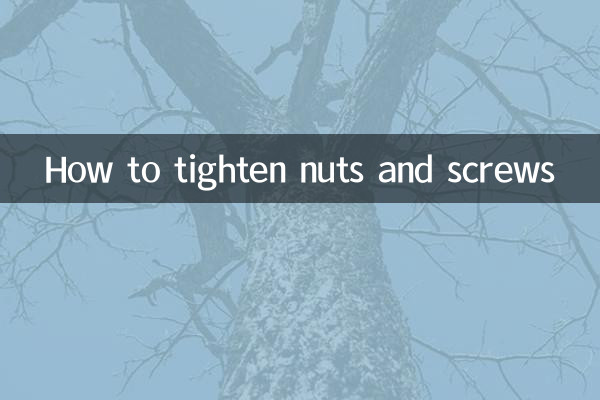How to tighten nuts and screws
Nut slippage is a common problem during routine maintenance or assembly. Sliding wires will cause the screws to fail to tighten properly, affecting the stability and safety of the equipment. This article will provide you with detailed solutions based on the hot topics and hot content on the Internet in the past 10 days.
1. Analysis of the causes of nut slippage

Nut slippage is usually caused by the following reasons:
| Reason | Description |
|---|---|
| Thread wear | Long-term use or improper operation results in thread wear and inability to engage. |
| Screw material problem | The screw material is too soft or has insufficient hardness and is easily deformed. |
| Improper operation | The angle is wrong or the force is too strong when tightening |
| Foreign matter enters | Foreign matter such as dust and oil enters the threads, affecting the bite. |
2. How to solve the problem of nut sliding
For different causes of slippage, the following methods can be used to repair:
| method | steps |
|---|---|
| Use a thread repair tool | 1. Clean foreign matter in the threads 2. Re-tapping using thread repair tool 3. Replace new screws or nuts |
| Filling glue or metal glue | 1. Clean the screw and nut surfaces 2. Apply metal glue or high-strength glue 3. Wait for the glue to solidify before tightening |
| Use spacers or spring washers | 1. Install a washer or spring washer under the nut 2. Increase friction on the contact surface 3. Retighten the screws |
| Replace screws with larger sizes | 1. Measure the original screw size 2. Choose larger screws 3. Re-tap and install |
3. Measures to prevent nut slippage
To prevent the nut slip problem from happening again, you can take the following preventive measures:
| measures | Description |
|---|---|
| Regular inspection | Regularly check the wear of screws and nuts and replace them in time |
| Correct operation | Maintain a vertical angle when tightening and avoid using excessive force. |
| Use the right tools | Choose a wrench or screwdriver that matches the screw to avoid tool slippage |
| keep clean | Regularly clean the dust and oil in the threads to ensure smooth bite |
4. Discussions related to the hot topics on the Internet in the past 10 days and nut sliding threads
According to the hot topics on the Internet in the past 10 days, the following are the focus of discussion among users on the issue of nut sliding:
| topic | Discussion content |
|---|---|
| DIY repair tips | Many DIY enthusiasts have shared their experiences in repairing sliding screws, especially using glue and spacers. |
| Tool recommendation | Users recommended a variety of thread repair tools, such as thread repair kits, metal glue, etc. |
| Material selection | Regarding the choice of screw material, users generally believe that stainless steel and high carbon steel are more durable. |
| Precautions | How to prevent slippage has become a hot topic, with users emphasizing the importance of regular inspections and correct operation. |
5. Summary
Nut slippage is a common but troublesome problem. Through the methods and preventive measures introduced in this article, you can effectively solve and avoid this problem. Whether using a thread repair tool, filling with glue, or replacing the screw with a larger size, we can help you restore the normal function of the screw. At the same time, regular inspection and correct operation are the keys to preventing slippage.
If you have other questions or experience sharing about nut sliders, please leave a message in the comment area to discuss!

check the details

check the details